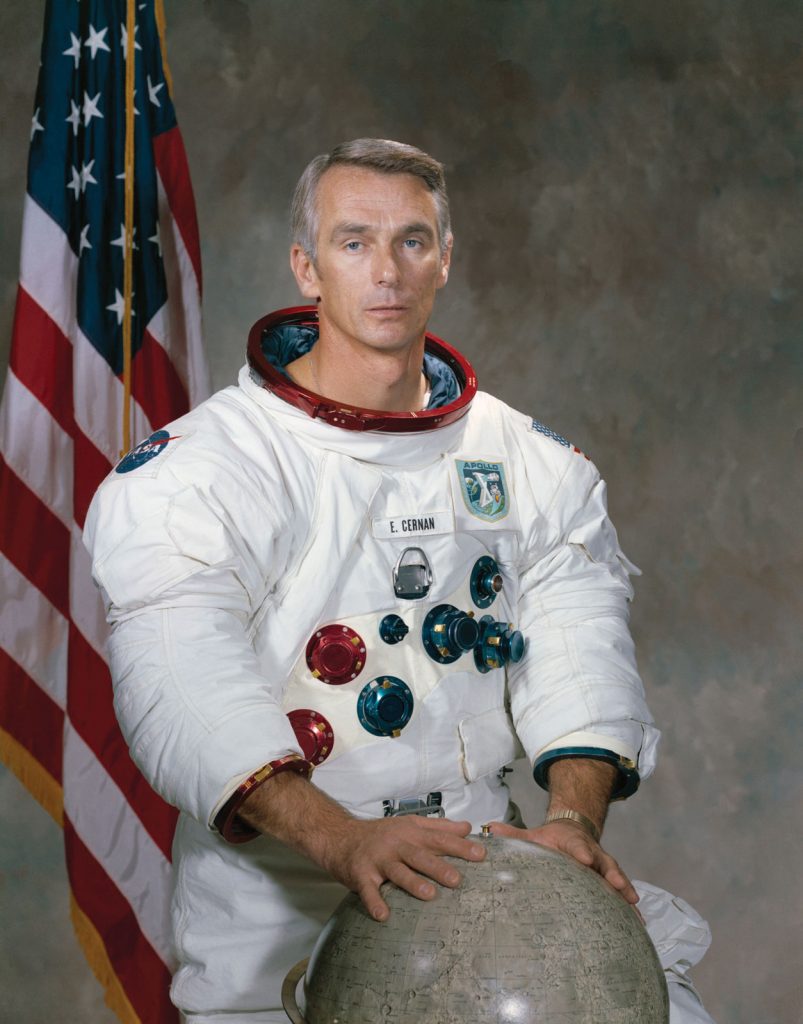Remembering the Last Man to Walk on the Moon- Eugene Cernan
For as long as mankind has been on Earth, we have been obsessed with the night sky. Countless hours, effort and money went into trying to understand the sky and everything that occurs beyond it. Man’s fascination with the starry sky dates back to ancient times. As science and technology progressed, we took steps to unravel those mysteries. Astronomy grew, and soon enough, we sent people to the people. Here’s a look at someone who led one of the most colorful lives possible. Let us take a moment to remember Eugene Cernan, the last man to walk on the moon.
Early Days
Eugene Andrew Cernan was born in 1934 in Chicago to a Slovak immigrant father and Czech mother. He was a very active boy while attending McKinley Elementary School, becoming a Second Class Boy Scout. He graduated from Proviso East High School in 1952, and soon joined Purdue University. While there, he was a Phi Gamma Delta fraternity member. He accepted a Navy ROTC scholarship right after his sophomore year. This scholarship required him to work aboard the USS Roanoke. In 1956, Cernan graduated with a B.S. in electrical engineering with a GPA of 5.1 on 6.0.
Military Career
Cernan underwent training with the Naval Reserve Officers Training Corps and became a U.S. Navy Ensign. His first posting after training from Purdue was on the USS Saipan. He later switched to active duty after completing flying training from Whiting Field, Baron Field and the Naval Air Stations in Corpus Christi and Memphis. He became a Naval Aviator and flew both the FJ-4 Fury and A-4 Skyhawk for squadrons 126 and 113. He graduated with an MS in Aeronautical Engineering from U.S. Naval Postgraduate School in 1963. His Navy career witnessed over 5,000 flying hours, out of which 4,800 hours were in a jet aircraft.
Taking to Outer Space
In 1963, NASA chose Cernan to be a part of their Gemini and Apollo programs. NASA chose Thomas Stafford and Cernan as backup pilots for Gemini 9. However, when NASA T-38A crashed killing the prime crew, they became the main pilots of the mission. Gemini 9A faced several setbacks including launch explosions and component failures. The crew fought against all odds and carried out several rendezvous to salvage parts. Cernan himself did an EVA, only the second American to do so, becoming the third person to ever do a spacewalk.
To the Moon and Back
Eugene and Stafford flew the Lunar Module for the Apollo 10 mission and collected data regarding lunar gravitational conditions. Two months later, this critical information allowed the Apollo 11 to land on the Moon. Though he was offered a chance to walk on the Moon during the Apollo 16 mission, he turned it down.
Budget cuts led to the cancellation of Apollo 15 and Apollo 19 in 1970, making Apollo 17, the last Apollo mission. In 1971, NASA launched Apollo 17, with Schmitt and Cernan handling the flying. The duo performed three EVAs lasting 22 hours on the Taurus–Littrow valley, covering over 35 km. He was also the last man to ever say anything standing on the Mo0on, and his final words were;
“America’s challenge of today has forged man’s destiny of tomorrow. And, as we leave the Moon at Taurus–Littrow, we leave as we came and, God willing, as we shall return, with peace and hope for all mankind. Godspeed the crew of Apollo 17.”
— Cernan, [14]
Eugene is one of three people to go to the Moon twice and one of only twelve to have walked on the lunar surface. Following the missions, he retired in 1976, as a captain. He later became the Executive Vice President of Coral Petroleum Inc. In 1981, he quit that company to found The Cernan Corporation. Eighteen years later, he published his memoir titled The Last Man on the Moon. He passed away at 82, in 2017 and was the first astronaut to be buried with full military honors at the Texas State Cemetery.
Legacy
Cernan also famously drew his daughter’s initials in the lunar dust as he was leaving for Earth. He holds the distinction of being the last human being to leave their footprints on the Moon. While working in the earlier missions, Cernan told Neil Armstrong about the white line his crew had painted in the sky to the Moon.
All Armstrong had to do not to get lost was follow the line and land, joked Cernan. His crew also captured the iconic photo, titled Blue Marble, showcasing the Earth in all her splendour. In many ways, Cernan embodied the human spirit, full of ambition to do things no one has done before.

Being a cinephile with a love for all things outdoorsy, Athulya never misses a chance to chase inspiring stories or poke fun at things, even when the subject is herself. Currently pursuing a degree in mechanical engineering, she is someone innately interested in technical and scientific research. Music reviews and op-eds define her as they allow her to explore different perspectives. Though sometimes she thinks she makes more sense playing the guitar than she does while writing.
